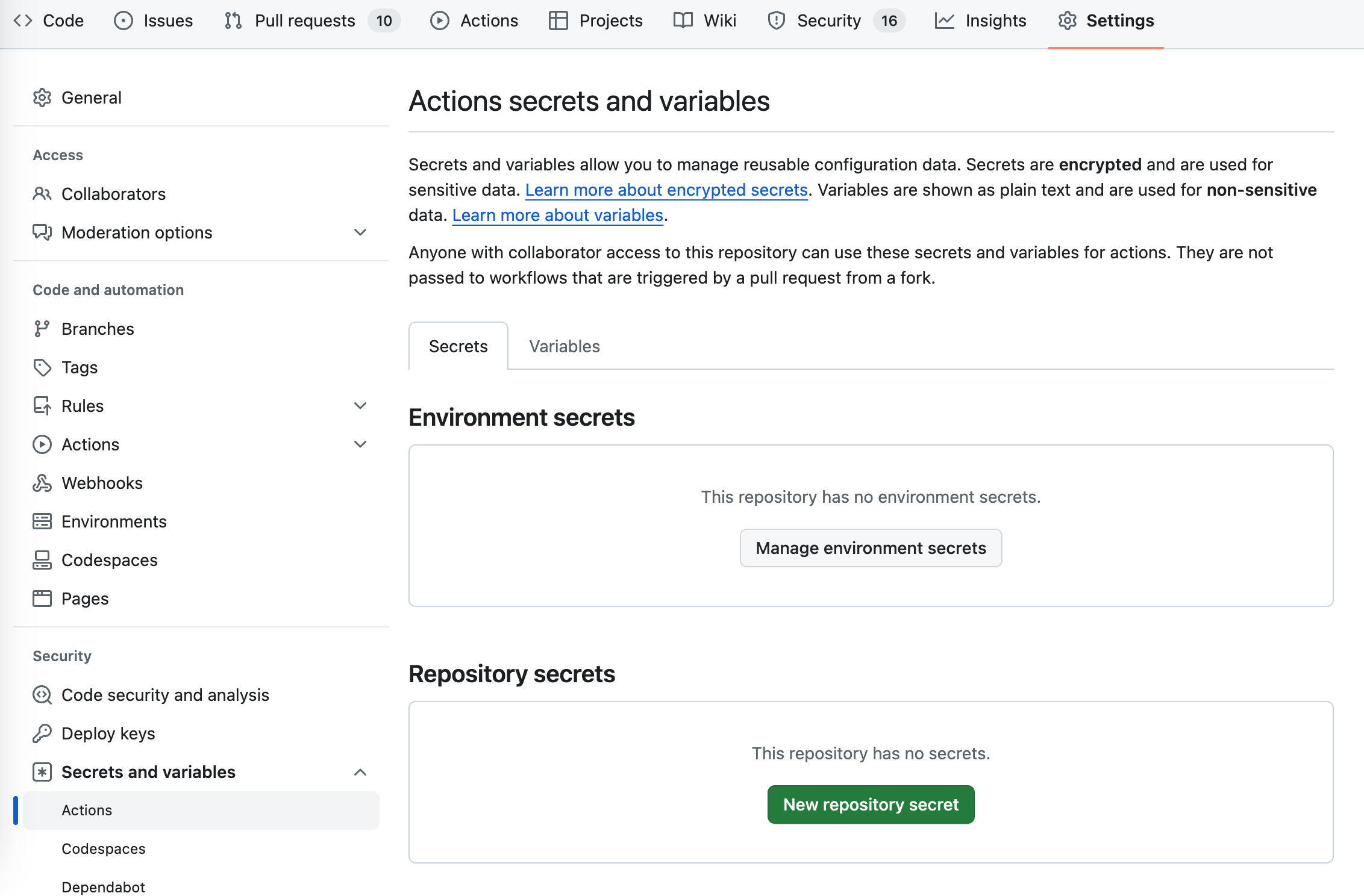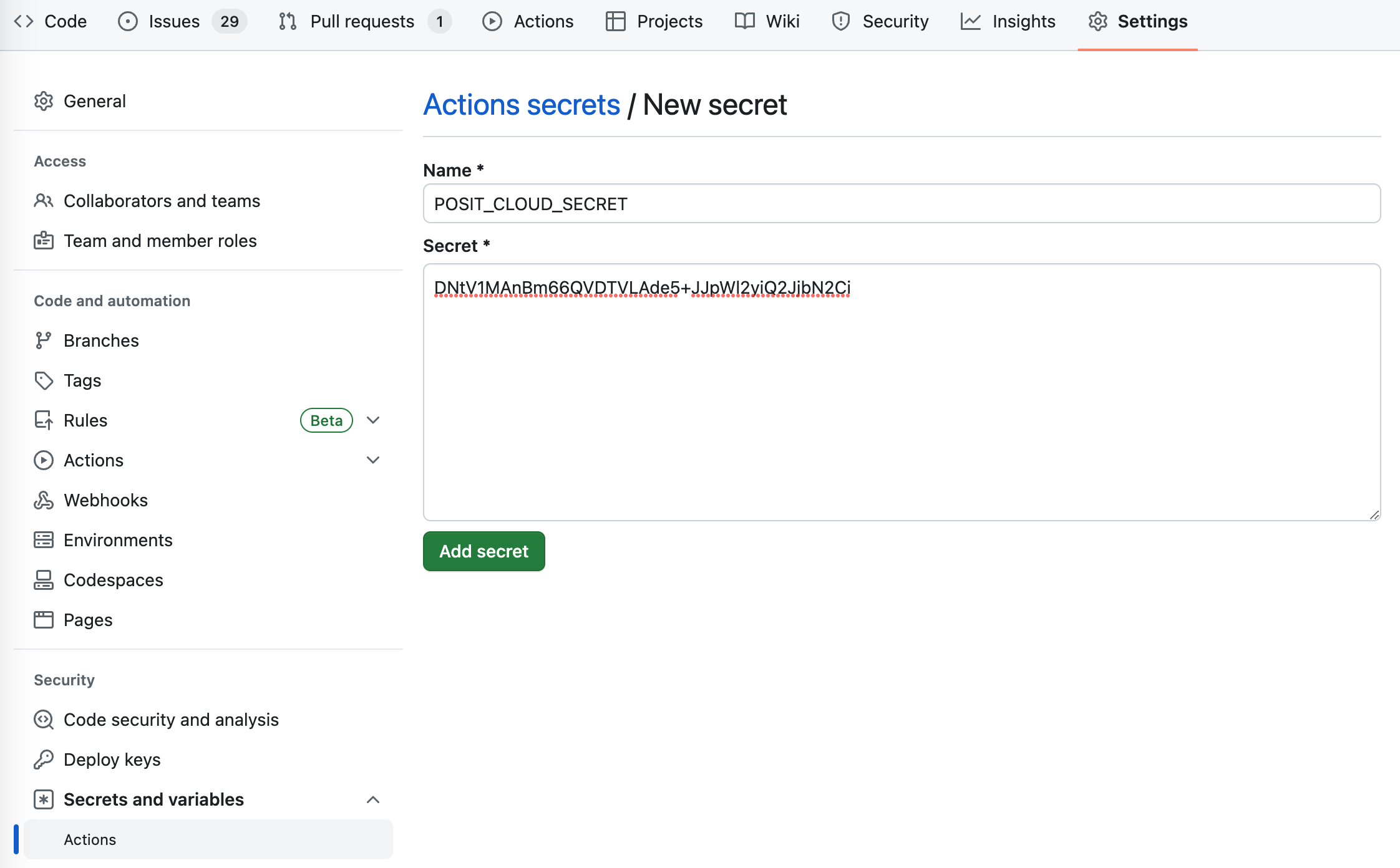Posit Cloud
This feature is new in Quarto 1.4. Download the latest version of Quarto at https://quarto.org/docs/download/.
Overview
On Posit Cloud, you can create data projects and publish results from your web browser. Use Posit Cloud when you want to organize all your static documents and interactive applications in one place.
There are several ways to publish Quarto content to Posit Cloud:
Use the
quarto publishcommand to publish static content rendered on your local machine.Use the rsconnect-python Python package or rsconnect R package to publish code for rendering on Posit Cloud.
Use a Continuous Integration (CI) service like Jenkins, Airflow, or GitHub Actions, to render and publish to Posit Cloud.
Each of these options is covered in detail below. If you are just getting started, we strongly recommend using the first approach (quarto publish). Then, as your needs evolve, you can consider other more sophisticated options.
Publish Command
The quarto publish command is the easiest way to publish locally rendered content. From the directory where your project is located, execute the quarto publish command for Posit Cloud:
Terminal
quarto publish posit-cloudIf you haven’t previously published to Posit Cloud you’ll be prompted to enter your token and token secret (available under Account > Tokens):
Terminal
$ quarto publish posit-cloud
? Token: › F69A5954CC09A97B7D74C73C6C7384EB
? Token secret: › ****************************************After authenticating, your content will be rendered and published, and then a browser will open to view its page on Posit Cloud.
A record of your previous publishes will be stored in a _publish.yml file within the project or document directory. This file stores the service, id, and URL of the published content. For example:
- source: project
posit-cloud:
- id: "1234"
url: "https://posit.cloud/content/1234"Account information is not stored in this file, so it is suitable for checking in to version control and being shared by multiple publishers.
You can customize this behavior of quarto publish by providing the following command line options:
| Option | Behavior |
|---|---|
--no-prompt |
Do not prompt to confirm publish actions. |
--no-browser |
Do not open a browser after publish. |
--no-render |
Do not re-render prior to publish |
To publish a document rather than a website or book, provide the path to the document:
Terminal
quarto publish posit-cloud document.qmdPublishing with Code
In the preceding example, we rendered content locally and then published it to Posit Cloud. In some cases, however, you may want to publish your source code to Posit Cloud and then have it rendered on the server.
The tools for publishing code differ depending on whether you are using the Knitr (R) or Jupyter (Python) engine, so we’ll cover them separately below.
Knitr (R)
The rsconnect R package includes a set of publishing functions that you can use for publishing Quarto projects with R code to Posit Cloud.
Your credentials can be found in Posit Cloud under Account > Tokens. To add your credentials, use:
library(rsconnect)
setAccountInfo(
name = 'abcde-nora-jones',
token = 'F69A5954CC09A97B7D74C73C6C7384EB',
secret = 'lcVIQGISmcSxG5VJhuRXNWHrWs7wLwaoubm8AcC7',
server = 'posit.cloud'
)Once your credentials have been added, you can publish your project. Here we publish a document and a website:
library(rsconnect)
deployDoc("document.qmd")
deployApp("./my-site")RStudio IDE
If you are using the RStudio IDE, there is also support for push-button publishing to Posit Cloud. Use the publish button ![]() from the source editor or viewer pane to publish a document or a website.
from the source editor or viewer pane to publish a document or a website.
See the Posit Cloud documentation on Publishing for additional details.
Jupyter (Python)
The rsconnect-python Python package provides a command line interface (CLI) that you can use to publish Quarto documents and websites that use Jupyter to Posit Cloud. To use the CLI:
First, install the rsconnect-python package and configure an Posit Cloud credential for publishing (values available under Account > Tokens):
Terminal
rsconnect add \ --account 'abcde-nora-jones' \ --name 'posit.cloud' \ --token 'F69A5954CC09A97B7D74C73C6C7384EB' \ --secret 'lcVIQGISmcSxG5VJhuRXNWHrWs7wLwaoubm8AcC7' \ --server 'posit.cloud'Then, use the
rsconnect deploy quartocommand from your project directory:Terminal
rsconnect deploy quarto
See the complete documentation on Publishing Quarto Content for additional details on using the CLI for publishing.
Continuous Integration
You can also deploy Quarto content using a Continuous Integration (CI) service like Jenkins, Airflow, or GitHub Actions. In most cases, this will entail scripting the quarto publish command, however in the case of GitHub Actions, you can take advantage of the standard Quarto publish action.
When publishing to Posit Cloud from a CI service you’ll need to consider whether you want to execute your Python or R code directly on the CI server or whether you want to take advantage of previously frozen execution results. We’ll explore this possibility first and then proceed to the specifics of how to publish from CI.
Freezing Computations
Depending on how complicated your run-time requirements (packages, database credentials, etc.) are, you might find it more convenient to restrict execution of Python and R code to local contexts that have the required software and credentials.
To make sure that R, Python, and Julia code is only executed locally, configure your project to use Quarto’s freeze feature by adding this to your _quarto.yml:
_quarto.yml
execute:
freeze: autoNow, fully re-render your site:
Terminal
quarto renderIf you have executable code in your project you’ll notice that a _freeze directory has been created at the top level of your project. This directory stores the results of computations and should be checked in to version control. Whenever you change a .qmd file with executable code, it will automatically be re-run during your next render and the updated computations will be stored in _freeze.
If you’d rather have CI publishing execute all Python and R code contained in your project, you’ll need to ensure that the requisite version of these tools (and any required packages) are installed on the CI server. How to do this is outside the scope of this article—to learn more about saving and restoring dependencies, see the article on Virtual Environments.
Publish Command
You can publish Quarto content to Posit Cloud using any CI service by scripting the quarto publish command. To do this, you’ll need to make sure that your credentials are available as environment variables on the CI server.
| Variable | Description |
|---|---|
POSIT_CLOUD_TOKEN |
A user’s authentication token. |
POSIT_CLOUD_SECRET |
The secret associated with the token. |
You will furthermore need to specify the ID of the target content to update. This will most frequently be drawn from the _publish.yml file that is saved into your project directory during publishing. For example:
_publish.yml
- source: project
posit-cloud:
- id: 1234
url: 'https://posit.cloud/content/1234/'Assuming that you have a _publish.yml like the above, you can publish to Posit Cloud from CI with the following commands:
Terminal
export POSIT_CLOUD_TOKEN=F69A5954CC09A97B7D74C73C6C7384EB
export POSIT_CLOUD_SECRET=lcVIQGISmcSxG5VJhuRXNWHrWs7wLwaoubm8AcC7
quarto publish posit-cloudAlternatively, if you don’t have a _publish.yml file, you can specify the ID on the command line as follows:
Terminal
quarto publish posit-cloud --id 1234GitHub Actions
If your CI service is GitHub Actions then you can take advantage of Quarto’s standard publish action to automate deploying to Posit Cloud.
User Credentials
Before creating the publish action, you need to ensure that your repository has the credentials required for publishing to Posit Cloud. You can do this as follows:
If you don’t already have one, create a token and token secret in Posit Cloud (under Account > Tokens).
Add the token secret to your repository’s action Secrets (accessible within repository Settings). Under Repository Secrets, you’ll see a New repository secret button:

Click the button and add the API Key from step 1 as a secret named
POSIT_CLOUD_SECRET:
Publish Action
To setup your publish action, create a .github/workflows/publish.yml file in your repository. If you are Freezing Computations (i.e. not running Python or R code within your action), then the file would look something like this:
.github/workflows/publish.yml
on:
workflow_dispatch:
push:
branches: main
name: Quarto Publish
jobs:
build-deploy:
runs-on: ubuntu-latest
steps:
- name: Check out repository
uses: actions/checkout@v4
- name: Set up Quarto
uses: quarto-dev/quarto-actions/setup@v2
- name: Render and Publish
uses: quarto-dev/quarto-actions/publish@v2
with:
target: posit-cloud
POSIT_CLOUD_TOKEN: F69A5954CC09A97B7D74C73C6C7384EB
POSIT_CLOUD_SECRET: ${{ secrets.POSIT_CLOUD_SECRET }}Once you’ve pushed your updated repository (including the publish action and _freeze directory) to GitHub, your action will run with this and subsequent commits, automatically rendering and publishing to Posit Cloud.
Executing Code
If you prefer, you can also configure GitHub Actions to execute Python or R code as part of rendering. While this might reflexively seem like the best approach, consider the following requirements imposed when you execute code within a CI service like GitHub Actions:
You need to reconstitute all of the dependencies (R, Python, or Julia plus the correct versions of required packages) in the CI environment.
If your code requires any special permissions (e.g. database or network access) those permissions also need to be present on the CI server.
Your project may contain documents that can no longer be easily executed (e.g. blog posts from several years ago that use older versions of packages). These documents may need to have
freezeindividually enabled for them to prevent execution on CI.
Prerequisites
The best way to ensure that your code can be executed within a GitHub Action is to use a virtual environment like venv or renv with your project (below we’ll provide example actions for each). If you aren’t familiar with using these tools check out the article on using Virtual Environments with Quarto to learn more.
Once you’ve decided to execute code within your GitHub Action you can remove the freeze: auto described above from your _quarto.yml configuration. Note that if you want to use freeze selectively for some documents or directories that is still possible (for a directory, create a _metadata.yml file in the directory and specify your freeze configuration there—this is what Quarto does by default for the posts folder of blog projects).
Example: Jupyter with venv
Here is a complete example of a GitHub Action that installs Python, Jupyter, and package dependencies from requirements.txt, then executes code and renders output to Posit Cloud:
.github/workflows/publish.yml
on:
workflow_dispatch:
push:
branches: main
name: Quarto Publish
jobs:
build-deploy:
runs-on: ubuntu-latest
steps:
- name: Check out repository
uses: actions/checkout@v4
- name: Set up Quarto
uses: quarto-dev/quarto-actions/setup@v2
- name: Install Python and Dependencies
uses: actions/setup-python@v4
with:
python-version: '3.10'
cache: 'pip'
- run: pip install jupyter
- run: pip install -r requirements.txt
- name: Render and Publish
uses: quarto-dev/quarto-actions/publish@v2
with:
target: posit-cloud
POSIT_CLOUD_TOKEN: F69A5954CC09A97B7D74C73C6C7384EB
POSIT_CLOUD_SECRET: ${{ secrets.POSIT_CLOUD_SECRET }}Example: Knitr with renv
Here is a complete example of a GitHub Action that installs R and package dependencies from renv.lock, then executes code and renders output to Posit Cloud:
.github/workflows/publish.yml
on:
workflow_dispatch:
push:
branches: main
name: Quarto Publish
jobs:
build-deploy:
runs-on: ubuntu-latest
steps:
- name: Check out repository
uses: actions/checkout@v4
- name: Set up Quarto
uses: quarto-dev/quarto-actions/setup@v2
- name: Install R
uses: r-lib/actions/setup-r@v2
with:
r-version: '4.2.0'
- name: Install R Dependencies
uses: r-lib/actions/setup-renv@v2
with:
cache-version: 1
- name: Render and Publish
uses: quarto-dev/quarto-actions/publish@v2
with:
target: posit-cloud
POSIT_CLOUD_TOKEN: F69A5954CC09A97B7D74C73C6C7384EB
POSIT_CLOUD_SECRET: ${{ secrets.POSIT_CLOUD_SECRET }}Additional Options
It’s possible to have a Quarto project in a larger GitHub repository, where the Quarto project does not reside at the top-level directory. In this case, add a path input to the invocation of the publish action. For example:
- name: Render and Publish
uses: quarto-dev/quarto-actions/publish@v2
with:
target: posit-cloud
path: subdirectory-to-use
POSIT_CLOUD_TOKEN: F69A5954CC09A97B7D74C73C6C7384EB
POSIT_CLOUD_SECRET: ${{ secrets.POSIT_CLOUD_SECRET }}By default, quarto publish will re-render your project before publishing it. However, if you store the rendered output in version control, you don’t need the GitHub action to re-render the project. In that case, add the option render: false to the publish action:
- name: Render and Publish
uses: quarto-dev/quarto-actions/publish@v2
with:
target: posit-cloud
render: false
POSIT_CLOUD_TOKEN: F69A5954CC09A97B7D74C73C6C7384EB
POSIT_CLOUD_SECRET: ${{ secrets.POSIT_CLOUD_SECRET }}